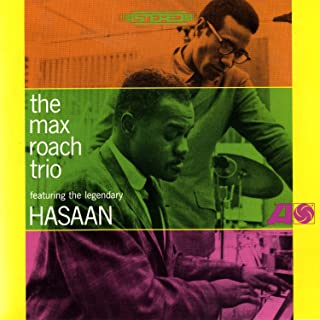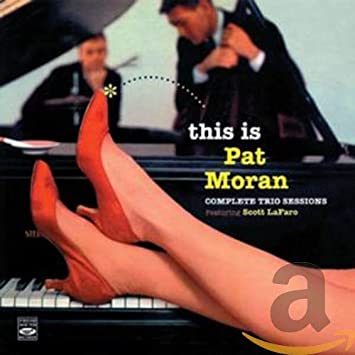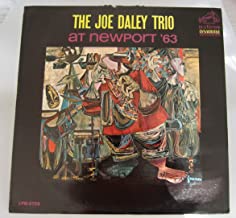-
Posts
13,205 -
Joined
-
Last visited
-
Donations
0.00 USD
Content Type
Profiles
Forums
Events
Blogs
Everything posted by Larry Kart
-
Perhaps in line with Chuck's original suggestion of The Complete Bobo Stenson, there's The Complete Oregon.
-
Cadillac Williams Joe Ford Joe Dodge
-
-
Also whichever of Herbie Nichols' Blue Note 10-inchers was the first. Depending on how you feel about Steig, but I think this was also Denny Zeitlin's debut: Not entirely sure if this was LaFaro's debut (he'd been a sideman with Buddy Morrow's band), but he was in sensational form on this one. Speaking of bassists, Russell Thorne!! Not only Russell's' debut but also perhaps his only commercial recording.
-
Yes, I knew Jim. Not as well as I might have, but our paths certainly crossed. Chuck Nessa knew Jim better than I did.
-
I had the great pleasure of reviewing "The Fox" for Down Beat when it it came out.
-

What Classical Music Are You Listening To?
Larry Kart replied to StarThrower's topic in Classical Discussion
The Falletta-conducted Rathaus Piano Concerto is also on You Tube. FWIW, maybe the second most melancholic piece I know (more acidic than the Rathaus and also on YouTube) is Constant Lambert's Concerto for Piano and Nine Instruments, dedicated to Lambert's composer friend Peter Warlock, a suicide, and with jazz elements evident at times. The You Tube performance with Richard Rodney Bennett is excellent. -

What Classical Music Are You Listening To?
Larry Kart replied to StarThrower's topic in Classical Discussion
For me, early Rathaus -- e.g. Symphonies No. 1 (1921-22) and 2 (1923) -- is interesting but to some degree all over the place in its at times aggressive and, I would say, unassimilated modernism -- I hear "voices"and gestures but not so much Rathaus' voice, and I don't think Yinon is the best advocate. Far better I think (I don't have strong memories of "The Last Pierrot") are such later works as Symphony No. 3 from 1942-3 (Yinon again), Suite for Violin and Orchestra (1929), Suite for Orchestra (1930), Serenade for Orchestra (1931), Polonaise Symphonique (1943), Uriel Acosta (1936), Vision Dramatique (1943) and, above all, Concerto for Piano and Orchestra (1967), which may be the most powerfuly melancholic piece of music I know. In these works the evolution of Rathaus' unique personal voice is unmistakable. The latter works mentioned above, beginning with Suite for Violin and Orchestra, are on CDs from Centaur (Joel Eric Suben conducting) and Koch (JoAnn Falletta conducting). Sym. No. 3, coupled with 2, is on CPO. Not to be missed on You Tube is Horenstein's live performance of Symphony No. 3. (You have to hunt a bit to find all four movements, but it's all there.) The question remains, at least for me: what is the nature of the mature Rathaus' voice? I feel a bit silly saying this, given all the differences involved, but I feel he has a kinship with Schubert. -
Like riding on a buckboard.
-
-
Shucks P.S. The part of those notes that seemed innovative/novel/potentially validl to me was the relationship I heard/drew between Brooks and Faure.
-

What Classical Music Are You Listening To?
Larry Kart replied to StarThrower's topic in Classical Discussion
I'd love to have that album. -
Listening again, I think Dixon was fine. BTW, I can't tell you what it was like to be in the audience for music like that. There were so many CJF highlights over the years, many of them as Chuck said shaped by him. And until I changed jobs at the paper I got to go back every night from Grant Park to Tribune Tower (now transformed into condos!!!) and write about what I'd heard.
-
"Tepid"? Sound quality? Surely not the music. As for sound quality, I only know the Mosaic box plus the original LP of "True Blue," so I can't compare with the various reissues. The main thing is do the reissues of "Minor Move" have the notes I wrote for that album in the Mosaic set? They were, I thought, a quite good and certainly heartfelt account of Brooks' career, and I'd hate to see that they'd been replaced.
-
Just kept a CD of Hovhaness' piano music with the composer at the piano -- it seemed to have a special authority -- and the Reiner "Mysterious Mountain." I also have a Columbia LP with the Ajemian sisters and on the other side Wolpe's "Ten Songs from the Hebrew" that I'll never get rid of.
-
Further culls: Hohvaness orchestral works (kept piano music played by Hohvaness) Gardner Read songs (kept his piano music) Benjamin Lees orchestral works (may have kept works for violin and piano) Herman Berlinski choral works George Barati orchestral works Takemitsu (dumped two discs, kept another) Max Schubel
-
Famous in some quarters, here below is an epic takedown of Martino from Richard Taruskin. Taruskin makes some semi-valid points, but he's also a consummate professional blowhard ass----, as he has proceeded to demonstrate on numerous later occasions. And when will people like Taruskin stop waving about that intemperate old Milton Babbit article as though it clinches their game? If Taruskin finds valueless all the music Babbit has written since then, he's an idiot. In any case, Taruskin on Martino: [Big gaps of space in what follows, keep scrolling] CLASSICAL VIEW CLASSICAL VIEW;How Talented Composers Become Useless By Richard Taruskin March 10, 1996 The nice thing about an-ism, someone once observed, is how quickly it becomes a wasm. Some musical wasms -- academic-wasm, for example, and its dependent varieties of modern-wasm and Serial-wasm -- continue to linger on artificial life support, though, and continue to threaten the increasingly fragile classical ecosystem. A pair of new Albany CD's of music by Donald Martino, now the Walter Bigelow Rosen Professor of Music Emeritus at Harvard, have recently come my way like a gust of musty air. They prompt me to throw open a window on the miseducation of musicians in America. One disk, consisting entirely of piano music, is especially dispiriting, precisely because the performances, by David Holtzman, are so superfluously good. The other contains two reissues of Nonesuch LP's ("Notturno," Mr. Martino's best-known piece, recorded in 1974, and Triple Concerto for three clarinets and chamber ensemble, recorded in 1978). There is also a brilliant performance by Mr. Holtzman of "Pianississimo," a virtuoso piano sonata composed in 1970 and hailed in its time by Andrew Porter as "a peak of 20th-century piano music." That such a critic could say such a thing of such a work is indeed a sign of times gone by, but there is still something that needs saying about this music. Once, a long time ago, in a famous article that ever since has served as a bible of academic arrogance, Milton Babbitt tried to laugh the audience's claims on 20th-century music right out of court. "Imagine a layman chancing upon a lecture on 'Pointwise Periodic Homeomorphisms,' he wrote. "At the conclusion, he announces, 'I didn't like it.' " Leaving the snobbery to one side, the analogy did make a philosophical point worth pondering. By comparing "serious" or "original" contemporary music to mathematics (and appropriating concepts like seriousness and originality to one kind of music was where the arrogance lay), Mr. Babbitt was saying, in effect, that such music was to be valued and judged not for the pleasure it gave but for the truth it contained. Truth, in music as in math, lay in accountability to basic principles of relatedness. In the case of math, these were axioms and theorems: basic truth assumptions and the proofs they enabled. In the case of music, truth lay in the relationship of all its details to a basic axiomatic premise called the 12-tone row. Again, Mr. Babbitt's implied contempt and his claims of exclusivity apart, the point could be viewed as valid. Why not allow that there could be the musical equivalent of an audience of math professors? It was a harmless enough concept in itself -- although when the math professors went on to claim funds and resources that would otherwise go to the maintenance of the "lay" repertory, it was clear that the concept did not really exist "in itself"; it inescapably impinged on social and economic concerns. Yet calling his work the equivalent of a math lecture did at least make the composer's intentions and expectations clear. You could take them or leave them. Honestly asserted, they had a certain authenticity, and so did the music. But now imagine that one engaged Claire Bloom to read "Pointwise Periodic Homeomorphisms" with all the expressive resources of voice and gesture she would bring to the role of Ophelia or Desdemona. Her performance would add nothing to the paper so far as the math professors were concerned. The "layman" would find something to admire in the beauty of her rendition (as anyone listening to Mr. Holtzman's performances of Mr. Martino's compositions on these Albany CD's will surely admire his sterling qualities of touch, timing and tone). And yet the lack of connection between the content of the utterance and the manner of its delivery would be a constant irritant both for the professors and for the layman. Both would find the performance somehow silly and gratuitous, though their reasons would vary, and though they might both be reluctant to say so. The incongruity would be equally manifest, moreover, whether Ms. Bloom read the paper in the seminar room or on the Stratford stage. That is the problem with Mr. Martino's piano music, which strives for conventional expressivity while trying to maintain all the privileged and prestigious truth claims of academic modernism. Because there is no structural connection between the expressive gestures and the 12-tone harmonic language, the gestures are not supported by the musical content (the way they are in Schumann, for example, music Mr. Martino professes to admire and emulate). And while the persistent academic claim is that music like Mr. Martino's is too complex and advanced for lay listeners to comprehend, in fact the expressive gestures, unsupported by the music's syntax or semantics, are primitive and simplistic in the extreme. Insofar as he seeks to be expressive, the composer is forced to do without language altogether. Where Schumann could make his most telling expressive points by means of subtle gradations of harmony, Mr. Martino can be expressive only in essentially inarticulate ways, the way one might communicate one's grossest needs and moods through grunts and body language. Huge contrasts in loudness and register, being the only means available, are constant. The combination of gross expressive gestures for the layman and arcane pitch relationships for the math professors is a perpetual contradiction. It fatally undermines the esthetic integrity of the music. The only harmonic support the composer can give the expressive surface is the occasional (and by now, old and tired) device of finagling some intermittent consonant harmony out of his Serial procedures. Composers who do this call it "tonal implication" or "tonal reference," but it is really nothing of the kind, because tonality is a syntax, not just a vocabulary. Invoking consonance is just another gross distinction, another primitive and largely meaningless gesture. THESE ARE HARSH judgments but necessary ones. Academic composers still maintain a smug front. In a 60th-birthday interview Mr. Martino was still blaming everyone but himself for the lack of headway his music had made despite all his prizes and plum academic posts. He was still heaping Babbittian scorn on "laymen," lobbying, as he put it, for a "potty-trained audience" and contending that "what we need are concert hall bouncers." And, of course, he was still simultaneously bragging that audiences disliked "Notturno," his Pulitzer Prize-winning sextet, and whining that his works were not more regularly performed before such audiences. The reason it is still necessary to expose these hypocrisies, even after the vaunted "post-modern" demise of Serialism, is that the old-fashioned modernist position still thrives in its old bastion, the academy. Composers like Mr. Martino are still miseducating their pupils just as he was miseducated himself, dooming them to uselessness. Critics and "theorists," many of them similarly miseducated, are still propagandizing for Pointwise Periodic Homeomorphisms in the concert hall, offering their blandishments as consolation for the loss of a musical language and decrying the attempts of younger composers to find a new one. Excellent performers like Mr. Holtzman, whose recordings of Stefan Wolpe show that his talents can be put to much better use, are still content to seek cozy academic approbation instead of seeking to establish a viable role for new music in the public sphere. It is not reinforcement in their contempt of audiences, or protection from them, that young composers and performers need, but encouragement in the risky business of establishing a new symbiosis with them. Mr. Martino and his music set an entirely negative example. The only constructive purpose the circulation of these records could serve today would be a cautionary one. A version of this article appears in print on March 10, 1996, Section 2, Page 31 of the National edition with the headline: CLASSICAL VIEW;How Talented Composers Become Useless. Order Reprints | Today’s Paper | Subscribe
-
That's about how I felt about the Martino concerto. Having heard with semi-positive feelings a fair amount of earlier Martino, some of which I kept for the time being, I can't imagine what he was thinking when he wrote that piece. It's pointlessly complicated noise.
-
My quarrel with the film, which I enjoyed by and large, is that the arc of the plot requires that Dexter's character be in bad shape physically and above all musically, then be regenerated/regenerate himself in France in both ways but especially musically, then return to the States where Martin Scorsese, playing an evil club owner, precipitates Dale Tallon's final decline and death. Problem was that at that point in his life Dexter could only play one way -- a very faded version of his former self -- and thus there was no musical regeneration present/audible for Dale Tallon on the screen. Did Tavernier see that this was a problem? Probably so, but I would assume that he could see no way around this and may have thought that the verisimilitude of Dexter's presence could make up for it.
-
Geez -- I should have made a list, and I've already dumped many of them in the library resale bin. From the ones I can remember and the ones that haven't gone there yet -- John Corigliano, Henry Brant (veteran experimenter whose "spatial" experiments don't come off IMO -- was tempted to keep his orchestration of Ives' Concord Sonata; sounds like a promising idea, but it's turgid), Harvey Sollberger (fine flute player, faceless composer IMO), David Chaitkin, Donald Martino's alto sax concerto and his Paradiso Choruses (kept other stuff by him), lots of Henri Lazaroff (why did I get any Lazaroff in the first place?), Dominick Argento, an Eighth Blackbird compilation, Nicholas Flagello (may have kept something else by him). Next time I go to the library, I'll make notes; probably most everything I donated is still there. Again, I was only going through modern American classical. Culling jazz would be a whole other proposition for me, for reasons I can't quite articulate right now. Culling modern classical from other countries and non-modern classical would be daunting, but I'll probably try someday. There's nowhere left around where I live where selling CDs is worth the trouble; you get almost nothing in return, and the buyers at Half Price Books are snarky these days. Donating CDs to the library feels better anyway. I haven't tried to sell anything this year, though I still go to Half-Price from time to time to see if there's anything I want to buy there -- usually not much.
-
"Coup de Torchon" (1981) with Philippe Noiret, based on Jim Thompson's "Pop. 1280," is something else. I think that was my first Tavernier, and ever since it's all been good.
_forumlogo.png.a607ef20a6e0c299ab2aa6443aa1f32e.png)




